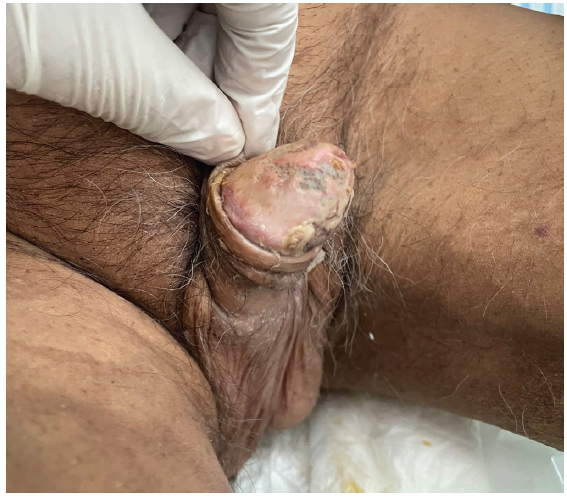Translate this page into:
Penile Calciphylaxis: A Rare and Life-Threatening Condition
Corresponding author: Jawad Iqbal Rather, Department of Nephrology, Sher-I Kashmir Institute of Medical Sciences, Srinagar, Jammu Kashmir, India. E-mail: jawadiqbal93@gmail.com
-
Received: ,
Accepted: ,
How to cite this article: Rather JI, Wani MM, Wani IA, Saleem N. Penile Calciphylaxis: A Rare and Life-Threatening Condition. Indian J Nephrol. doi: 10.25259/IJN_111_2025
A 55-year-old man with hypertension, type 2 diabetes mellitus, and end-stage kidney disease on maintenance hemodialysis via a left brachiocephalic arteriovenous fistula for three years presented to the nephrology unit with severe pain in the penile region for the last 20 days. Examination showed a palpable radial artery wall. Penile examination revealed multiple necrotic and very tender lesions on the glans [Figure 1]. His corrected total serum calcium, parathyroid hormone, and Vitamin D were were 8.9 mg/dL and 8.5 mg/dL, 814 pg/mL, and 45 ng/mL, respectively. X-ray legs showed diffuse vascular calcification. Penile calciphylaxis was diagnosed clinically based on exquisitely painful lesions and typical penile lesions.

- Multiple necrotic lesions on the glans.
Calciphylaxis is a rare, life-threatening entity characterized by painful skin lesions caused by microvascular occlusions in the cutaneous tissue. It has a predilection for areas with subcutaneous adiposity, such as the abdomen, thighs, or breasts, than those with limited subcutaneous adiposity (e.g. distal or peripheral areas, such as toes or fingers).1 Penile involvement is rare, but has a dismal prognosis with a median survival of 3.8 months.2 The diagnosis is made clinically. The role of biopsy is debated because of the lack of specific histological features. Moreover, biopsy increases the infection risk, bleeding, necrosis, and propagation of additional lesions.3 Management is multidisciplinary, involving nephrologists, dermatologists, palliative care specialists, plastic surgeons, and nutritionists.4 Treatment involves wound management, nutrition, addressing risk factors, and a sodium thiosulfate trial. The patient was managed with wound care and analgesia. The patient died one month after diagnosis.
Conflicts of interest
There are no conflicts of interest.
References
- A nationally representative study of calcific uremic arteriolopathy risk factors. J Am Soc Nephrol. 2016;27:3421-9.
- [CrossRef] [PubMed] [PubMed Central] [Google Scholar]
- Penile calciphylaxis: A retrospective case-control study. J Am Acad Dermatol. 2021;85:1209-17.
- [CrossRef] [PubMed] [Google Scholar]
- Advanced-stage calciphylaxis: Think before you punch. Cleve Clin J Med. 2016;83:562-564.
- [CrossRef] [PubMed] [Google Scholar]
- Multi-intervention management of calciphylaxis: A report of 7 cases. Am J Kidney Dis. 2011;58:988-91.
- [CrossRef] [PubMed] [Google Scholar]







